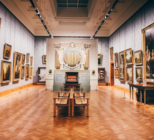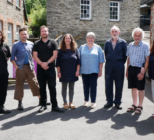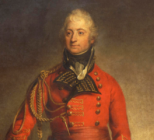The Iron Age building, which is now open to the public, is based on an archaeological site from the time of the Roman conquest, is a recreation of a small Iron Age farmstead near Llansadwrn in the eastern corner of Anglesey and was built with the help of hundreds of volunteers, including schoolchildren and members of neighbouring communities in Ely and Caerau.
Together with the Museum’s own building team, the volunteers raised up the clay walls, helped to interpret the history of the houses and rediscovered the lives of its original inhabitants.
Escorted school groups have been visiting Bryn Eryr for the past year but now the general public has access to the site. This rural settlement consists of two roundhouses built with six-foot thick clay walls and large conical thatched roofs.
The project has been made possible with funding from an £11.5m HLF grant (awarded in 2012), as well as additional funds from the Welsh Government and private supporters.
“The reconstruction of this exceptional lost building from Anglesey, using archaeological evidence, is a significant part of the redevelopment of St Fagans,” said David Anderson, Director General Amgueddfa Cymru – National Museum Wales. “For the past five years, we have been communicating the value of the redevelopment project for the people of Wales and beyond. With the opening of Bryn Eryr, our visitors now have a place to hear ancient stories, learn traditional skills and share experiences with their friends and families.”
St Fagans National History Museum is the second most visited open-air museum in Europe and Wales’ most popular heritage attraction with more than 600,000 visitors annually. A total of 40 buildings have been moved from locations all around Wales and re-erected at the museum including a post office, farmhouses and a medieval church.
The Making History project will totally refurbishing the main building with new international-standard galleries, a temporary exhibition space, an extensive contemporary centre for learning and a collections research centre. It will also see the construction of new buildings across the site including a sustainable building for craft and making (Gweithdy), and reconstructing two significant, lost buildings from archaeological evidence, the recently completed Bryn Eryr Iron Age Farmstead and Llys Llywelyn, a reconstruction of a Medieval Princes’ Court
The project will also open up and developing more of the historic landscape and buildings creating greater physical and online access to the collections and enriched digital resources
The museum and historic buildings will remain open while the visitor experience is completely transformed as part of the project.
“The reconstruction of Bryn Eryr has been years in the making, with attention paid to even the smallest of details to ensure the finished farmstead would be as authentic as possible,” said Richard Bellamy, Head of the Heritage Lottery Fund in Wales.
“It’s pleasing to note that hundreds of volunteers have given up their time to help make this reconstruction possible and engage in our heritage – and they deserve a special thanks for their dedication. I cannot wait to see the other buildings and exhibition spaces completed – it will ensure that St Fagans will be better than ever, helping tell the Welsh story to the world.”
The Making History project will also deliver new events and activities across the site, as well as the creative use of our archives and collections, to provide unforgettable opportunities to learn new skills
There will be free family drop-in activity sessions about Bryn Eryr, life in an Iron Age farmstead during the school summer holidays
Mon 8- Sat 13 August 12-3pm.
Mon 22 – Sat 28 August 12-3pm.










